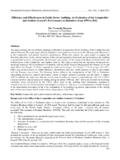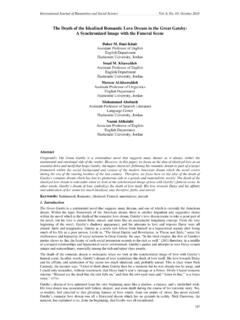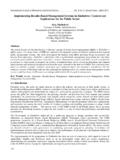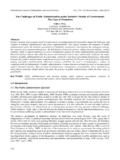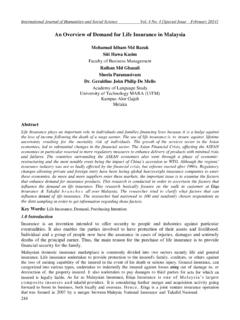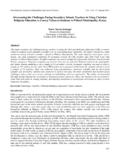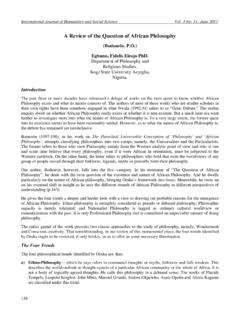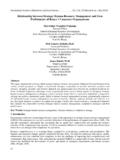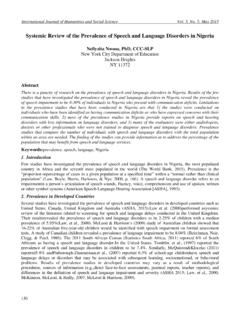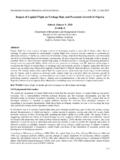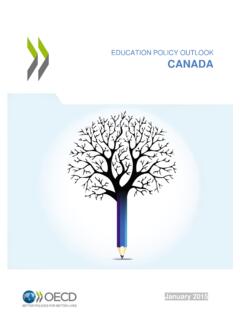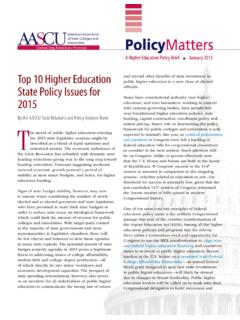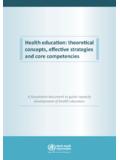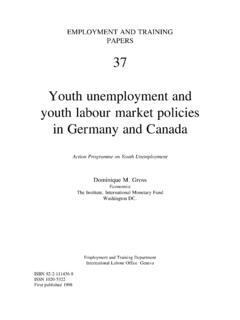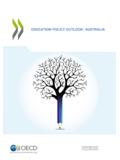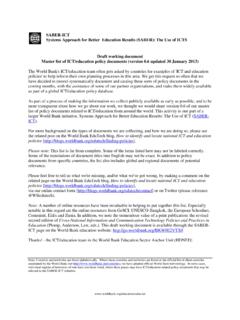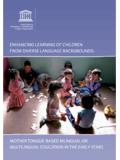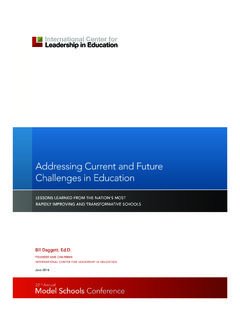Transcription of Public Policy Making in Zimbabwe: A Three Decade …
1 International Journal of Humanities and Social Science Vol. 2 No. 8 [Special Issue April 2012] 212 Public Policy Making in zimbabwe : A Three Decade Perspective Dr. Gideon Zhou Mr. Zvoushe Hardlife University Of zimbabwe Department of Political and Administrative Studies, P. O. Box Mp167, Mt. Pleasant Harare, zimbabwe Abstract This article reviews how the interplay of socioeconomic dynamics shaped Policy decisions over the decades. Research findings suggest that the spirit and temper of Policy decisions generally bear the imprint of the prevailing macro dynamics. During the first Decade of independence, the imperative of nation building informed Policy decisions across all sectors of the economy.
2 Policy Making was interventionist and social welfare oriented. During the second Decade when the state was in economic crisis, Policy interventions were mainly contractionary and low note on local ownership and social acceptance. Third Decade policymaking was under highly untenable social, political, and economic conditions. A climate of siege and anxiety prevailed within state and civil society. Though the substantive intents of major policies adopted during this Decade were in rhythm with the post independence imperatives, Policy Making approaches had a partisan, temperamental, exclusionary, hurried, and short-term bent. Introduction The Rationale While various conceptions of Public Policy have emerged in literature over the years (see Anderson, 2005; Pal, 1989; Dye, 2002), definitions generally locate the source of Public Policy in government.
3 By virtue of this source, Public policies are legally binding, Public ends-driven and universal in application. They apply to those within the state and non-state sector. The issue of source as a defining characteristic of Public Policy that distinguishes it from private Policy is aptly captured by Pal (p: 5) who observes that what makes a Policy a Public Policy is not its impact but its source (our emphasis). Dye (p: 12) also underlines this thus a Policy does not become a Public Policy until it is adopted by some government institution . As distilled from these definitions, Public policies denote courses of action or inaction taken by a government in response to a known problem or set of problems.
4 Policy problems are those conditions or situations that produce dissatisfaction on a wide spectrum of people and for which government redress is sought (Anderson, 79). The above remarks point to an organic relationship between Public policies and government institutions. The nature of government (its institutional and leadership practices), have a direct bearing on Public policies while Policy outcomes in turn impact on government legitimacy. Public policies are central instruments through which the fundamental choices of the political authorities are executed (Dye, 14). They regulate societal behavior and extract, allocate and distribute resources to different segments of society within the economy.
5 They thus play key promotional roles in national socioeconomic development. Soundly crafted national policies provide feasible channels through which governments communicate and respond to citizen demands. They enable society to read and interpret the mindset and priorities of the national leadership. Public policies also serve as key instruments at both the domestic and international fronts. At the domestic level, they serve as mechanisms of conflict management, harnessing and balancing competing values and interests within the nation. Individuals who comprise society hold different and often conflicting values on what Policy problems, goals and options should be prioritised at a given time.
6 At the international level, Public policies constitute means through which governments relate and market themselves to the outside community. Underlined here is the need to ensure that due attention is given to the formulation of both domestic and foreign policies. Domestic policies in the form of land Policy , defence Policy , tax Policy , labour Policy , investment Policy communicate certain messages to the regional and international community. The Special Issue on Contemporary Issues in Social Science Centre for Promoting Ideas, USA 213 Notwithstanding these positive attributes, gaps usually exist between Policy intents and Policy action. Well intentioned Public policies do not always deliver benefits to target groups.
7 They have notoriety for benefitting third parties. Hidden agendas are also pursued under the guise of Public motive. As observed by Pal (1996, 6), beyond official or explicitly stated goals are the unstated or hidden ones--but which in practice usually influence Policy decisions . The Public motive is best served where Public Policy Making processes are inclusive, transparent, accountable and responsive. Equally important is the need to appreciate the intimate link between Public policies and their ecological contexts. In fact, Public policies in terms of content and practice usually carry the imprint of their environment. Each environment has its own set of socio-politico-economic dynamics which interact to either facilitate or disable sound Policy Making in the polity.
8 Implied here is that Public Policy Making is inherently embedded in the politics of its environments. A study of Public Policy Making in any country inevitably raises fundamental questions on the nature of the state politics. Viewed from this angle, a Three Decade study of Policy Making in zimbabwe should unravel how the interplay of socio-politico-economic dynamics in each Decade influenced and shaped the Policy Making approaches and practices. It should help us characterize Policy Making in post independence zimbabwe . Reference to milestone Policy decisions is made throughout the study in order to analyze issues within their empirical contexts. First Decade Policy Making zimbabwe achieved its independence in 1980 after a gruelling seven year armed struggle.
9 This historical reality remains a decisive factor in national Policy decision Making to this day. At independence, the new government faced the pressing challenge of reconstituting and realigning the inherited national Policy Making structures in line with the new socio-politico-economic dispensation that had set in. Inherited national Policy Making systems and processes needed to be transformed from minority-focused to majority-focused institutions. The inherited economy was also fraught with embedded inequalities in income and wealth distribution, with the agricultural, education , industrial and banking sectors among the most visibly affected. Against this background, the need to address inequalities and injustices wrought by yesteryear policies underpinned Policy Making during the first Decade .
10 It also underlined the state-centric nature of Policy Making in parastatal, agricultural, health, education , labour and social welfare sectors. The new government viewed itself first and foremost as the central instrument through which yester-imbalances were redressed. Reconciliation Policy The nationalist agendas of nation building are most manifest in the adoption of the Policy of reconciliation in zimbabwe immediately after the attainment of independence. The Policy was based on the need to build sustainable peace, equality and peaceful co-existence between races and ethnic groups in the country. This Policy thus symbolized a radical departure from the yester era of racial discrimination and parallel co-existence.
